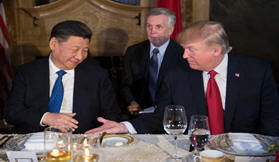www.aljazeerah.info
Opinion Editorials, January 2019
Archives
Mission & Name
Conflict Terminology
Editorials
Gaza Holocaust
Gulf War
Isdood
Islam
News
News Photos
Opinion Editorials
US Foreign Policy (Dr. El-Najjar's Articles)
www.aljazeerah.info
While US Wall Reflects Backward Policies, China Global Roads Link Countries By James Petras Al-Jazeerah, CCUN, January 20, 2019 |
 |
 |
|
Walls or Roads
History is told by Walls and
Roads which have marked significant turning points
in the relation
between peoples and states.
We will discuss the story behind two walls and one road and the
circumstances
which surround them and their consequences.
The Berlin Wall
In the aftermath of World War II, Europe was divided between East and
West.
On one side the Soviet Union (SU) and its Communist allies and
on the other the United
States and its Capitalist partners.
The Soviets faced a formidable task in rebuilding their sector having
lost tens of
millions of soldiers and civilians and facing great
scarcities of resources without aid from
the wealthy West. North
America sought to roll-back the post war agreements and
proceeded to
subvert the East by promising higher living standards, greater cultural
and
personal freedom. The East resorted to greater control and
sacrifice in order to
reconstruct their economies. The unequal
contest between East and West in terms of
personal consumption was
contested by the more radical social investments in national
public
health, educational and social programs.
The West succeeded in attracting professionals, skilled workers and
important
cultural figures by offering attractive economic and
individual incentive which the East
could not or would not match.
In order to contain the ‘brain drain’ the East adopted repressive
measures
including building what was later referred to as the Berlin
Wall. Despite physical
obstacles Easterners fled across and under
the Wall.
When the East succumbed to pressure and internal opposition, the
economy was
taken over by the capitalist West which incorporated
most of their factories and workers
under control by private foreign
capitalists. Hundreds of thousands of workers in the
East suffered
unemployment and loss of social welfare and millions moved to western
countries.
The former Eastern countries were annexed into the Western military
alliance(NATO) and were incorporated into US wars in the Balkans,
the Middle East and
Southern Asia.
The end of the Wall strengthened the US military and increased the
wealth of the
European Union. The Soviet Union disintegrated, and
Russia was impoverished, and its
economy pillaged for over a decade.
Eventually Russia recovered and regained its
sovereignty ,
independence and its status as a world power.
The US Wall: Mexico and Central America
The
mass migration of Central Americans and Mexicans was directly linked to
two essential factors:
NAFTA and the US intervention in the civil wars in Guatemala, El
Salvador,
Honduras and Nicaragua.
The US coup in Guatemala in 1954, Washington’s massive million dollar
a day
intervention in the El Salvador revolution and the 3 decades
of Pentagon support for the
Somoza dictatorship in Nicaragua and the
military coups in Honduras resulted in the
killing of over 400,000
Central Americans while over 2 million Central Americans were
uprooted, tortured, jailed and forced to flee across the Mexican - US
border.
The flood of refuges, products of US imperial wars’, crossed into the
US seeking
safety and employment. The US refused humanitarian
assistance, hundreds of thousands
were denied entry or were
expelled.
In Central America,Washington backed the military and oligarchies
which controlled
the land , evicted farmers and denied land to the
returning peasants.
The US responded by expanding the border police and immigration
security
forces, seizing and expelling tens of thousands of hard
working refugees. Walls were
built along the Mexican frontier, to
prevent refugees from crossing the border,
condemning them to
violence and misery.
Millions of Mexican peasants were displaced
by the NAFTA agreement which
promoted US agro-exports which undercut
Mexican staples. NAFTA undermined US
industrial workers as
multi-nationals sought low wages.
Bankrupted farmers in Mexico sought to cross the border.
They were joined by tens of thousands of Mexicans who fled from the
drug
cartels which were protected by US allies among the corrupt
Mexican politicians, police
and army. The drug cartels reaped tens
of billions of dollars by laundering their drug
profits in the
leading New York, Miami and Los Angeles banks. The Wall kept Mexican
workers out while the US government allowed drug money in-- to flow to
US bankers
which profit from the drug laundering.
The conflict in the US between the two parties is an argument over
the methods of
denying the refugees entry-- “walls” versus
“barriers”-- but not over US bank laundering
and NAFTA. The US Wall
protects profiteering and punishes its victim by keeping
them out.
China’s Belt and Road: Opening Borders
Contrary to the US mania for Wall building on the Mexican border
blocking
refugees, President Xi Jinping has allocated $900 billion
dollars for roads and
infrastructures to open China extend links
with South and Central Asia, the Middle East,
East Africa and Europe.
China is building sea ports, roads, airports,-- opening trade,and
increasing the flow of labor to markets and investments.
China
does not face refugees fleeing from US invasions as is the case of the
Central Americans. Nor are Chinese agricultural exports displacing
farmers, as is the
case of Mexicans bankrupted by NAFTA.
China’s One belt, One Road (OBOR) promotes regional and international
integration – in contrast to US imposed disintegration of Central
American linkages.
China promotes free trade agreements with its
Asian partners in opposition to US
protectionist tariffs and walls.
China’s OBOR policy is based on promoting the upgrading of
underdeveloped
countries in order to complement China’s advanced
technological exports.
Conclusion
Walls are built by the US to constrain the fallout from its Central
American wars
and unequal trade agreements with Mexico. The Soviet
Wall was constructed to protect
is backward, uncompetitive economy.
China needs infrastructure, breaking walls, to facilitate the flow of
goods and
services across borders and incorporating labor, not
arresting and expelling it.
The Walls reflect backward and regressive policies; global roads and
belts link
countries to peaceful and productive global integration.
***
Share the link of this article with your facebook friends
|
|
|
|
||
|
||||||


